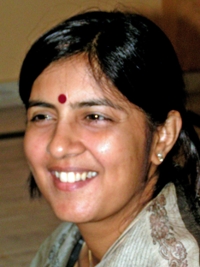Mahatma Gandhi was the first to popularize the term Sarvodaya, meaning "Welfare of All" by using as the title of his translation of John Ruskin's work, Unto This Last. By way of choosing this word, he wanted "to translate Ruskin's message [his vision of a future society], and later, [...] to symbolize the spiritual revolution prescribed by Gandhian utopia."[48] Many of these pan-Indic movements focused and shared the ideals of nonviolence, truth and self-reliance. In an effort to broaden our understanding of Tulsi's contemporaries, I will examine four such movements that aspired for a better society and shared Gandhi's heritage - either in his philosophy or in his legacy. They are the Anuvrat Movement (1949); the Bhoodan Movement (1951); the Sri Lankan Sarvodaya Movement (1958) and the Chipko Movement (1971). The prime objective of these post-colonial movements was to regain social stability by reconstituting the social life.
The Anuvrat Movement
Acharya Tulsi was a pioneer of these reconstituting movements, beginning his movement as early as 1949. His platform evolved out of traditional Jain values and he was able to demonstrate a well-fortified Gandhian paradigm. As the Indologist Peter Flugel observes: "Tulsi created the nonreligious Anuvrat Movement for the implementation of nonviolence and morality in social life."[49] Mahatma Gandhi singled out nonviolence from the scriptures and applied it effectively as a technique for political change, whereas Tulsi carved out nonviolence from the scriptures for fostering social change.
The Bhoodan Movement
Vinoba Bhave, the spiritual heir of Gandhi, launched the Bhoodan Movement in 1951 in the Pochampalli village in the Telengana region of Andhra Pradesh.[50] The movement's mission was to persuade wealthy landowners to voluntarily give a portion of their land to poor peasants, a concept strongly tied to the Eastern religious practice of non-possessiveness. Raghavendra Nath Misra, in his book, An Economic Assessment of the Bhoodan Movement in India, notes that Vinoba derived his philosophy for the movement from the classic Hindu text the Gita.[51] Vinoba, a layman demonstrated great asceticism, and like Tulsi, he walked on foot across the Indian sub-continent in order to persuade landowners to gift their land to the landless. Even though both the movements were action-oriented, the main difference between the two was that: Vinoba focused on "gifting land," and Tulsi focused on "small vows" for self-restraint. Vinoba Bhave, through his movement attempted a social-economic development of post-independence India whereas Acharya Tulsi's purpose was the regeneration of humans on spiritual-ethical grounds.
The Sarvodaya Shramdana Movement
A. T. Ariyaratne, a Buddhist layman, launched the Sarvodaya Shramdana Movement in Sri Lanka in 1958. He notes: "We in Sri Lanka were inspired by this Sarvodaya thought of Gandhi and the Bhoodan-Gramdan action of Acharya Vinoba Bhave."[52] In forming the ideology of the movement, Ariyaratne believed that the Buddhist Dhamma teachings would provide a blueprint for a new social order and a nonviolent revolution.[53] Interestingly, he redefined Gandhi's Sarvodaya "Welfare of All" as "Awakening of All."[54] As noted by a human development theorist Dennis Goulet: "Sarvodaya reinterprets the Middle Path for the technological age."[55] Goulet's assessment implies that Ariyaratne adopted appropriate technology in his developmental projects while remaining true to his Buddhist tradition.
The Chipko Movement
By 1970, the Chipko Movement, which had a great impact in Northern India, was led by two followers of Gandhi - Sunderlal Bhauguna and Chandi Prasad Bhatt. "Chipko," loosely translates as hug, was a movement that originated in the Indian Himalayas and was dedicated to saving trees by hugging them, if necessary, when loggers came to cut them down.[56] It was yet another example from the post-independence India of how the non-violent resistance and struggle of thousands of ordinary people without the presence of an especially charismatic leader could succeed under certain circumstances.[57] The Chipko movement explored nonviolence for the protection of the environment.
1973), 17.
Blackwell, 2002), 230.
 Shivani Bothra
Shivani Bothra
